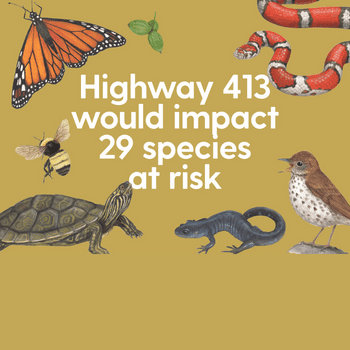Concern focused on Ontario’s lack of data and reckless approach to species at risk, navigable waters and duty to consult with Indigenous communities
Toronto | Traditional territories of the Mississaugas of the Credit, the Anishinaabeg, the Haudenosaunee, and the Wendat – A recent Access to Information and Privacy (ATIP) release has revealed a litany of concerns expressed by the federal government about Ontario’s approach to protecting key values threatened by the proposed construction of Highway 413. This includes the revelation that the largest remaining habitat for the critically endangered Western Chorus Frog in Ontario directly overlaps with the proposed route of the Highway.
The 68-page trove of previously unreleased documents reveals significant concerns about values that must be protected under federal jurisdiction as required by the Species at Risk Act (SARA), the Fisheries Act, the Migratory Birds Convention Act, the Canadian Navigable Waters Act and the Duty to Consult under Section 35 of the Constitution.
“These new records further validate long held concerns about this highway,” said Tim Gray, executive director at Environmental Defence. “The Ontario government is trying to recklessly push forward with Highway 413 in a way that harms species at risk and considers Indigenous consultation an afterthought.”
Federal departments communicated concerns about Ontario’s approach to species at risk including how data collection is being undertaken, the lack of protection for certain species and questionable proposals for the relocation of species at risk. The ATIP revealed that the largest remaining Western Chorus Frog critical habitat area lies in the direct path of the Highway 413 project (ATIP, pg. 24). Environment and Climate Change Canada scientists flagged that the highway routing seemed to be pre-determined and that alternative route assessments were not completed for species at risk such as the Western Chorus Frog, Red-Headed Woodpecker and Rapids Clubtail (ATIP, pg. 23).
The ATIP release also highlighted apprehension from the federal government about the highway due to its potential impact to the navigable waters of the Credit River, Etobicoke Creek and Humber River due to changes in water infiltration and base-flow as a result of paving large sections of the headwaters for each of those rivers (ATIP, pg. 27-28). Other concerns include a lack of information on current Indigenous traditional uses, such as hunting, fishing or gathering, by Indigenous communities and the project team’s lack of engagement with Indigenous Knowledge Keepers (ATIP, pg. 42).
“The concerns identified in this ATIP clearly show that the federal government needs to immediately re-designate this risky and expensive highway for a full federal Impact Assessment,” said Gray.
Full ATIP overview and release are available HERE.
ABOUT ENVIRONMENTAL DEFENCE (environmentaldefence.ca): Environmental Defence is a leading Canadian environmental advocacy organization that works with government, industry and individuals to defend clean water, a safe climate and healthy communities.
– 30 –
For more information or to request an interview, please contact:
Carolyn Townend, Environmental Defence
media@environmentaldefence.ca







